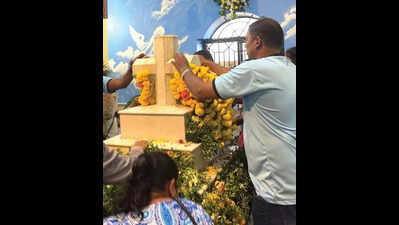ARTICLE AD BOX

Panaji: A unique celebration linked to an efficient, age-old water management system drew thousands to Khandi Khuris at Maina-Curtorim on Wednesday, where a ‘rice first’ policy since hoary times has sustained agriculture.
With Goa fast becoming a ‘city state’ — it has over 50 census towns, and many villages have nearly quit agrarian traditions — Maina stands out for its agro-ecological practices.At noon, firecrackers marked the bunding of the ‘handi’ or ‘khandi’ (sluice gate), as farmers began a thanksgiving litany for the water storage ritual. Devotees thronged the 2-km bundh — an eastern barrier of Sonbem lake for water harvesting that overlooks a scenic khazan and rolling blue hills.The farmers’ dedication for years has helped keep the fields fertile and the environment radiant, without salinity problems and mangrove invasion that have devastated khazans in other parts of Goa. The agrarian practices are governed by some sagacious oral traditions.“For the farmers, who manage their agriculture through rotation in three groups, rice comes first,” said chairperson of the Curtorim biodiversity management committee, J Santano Rodrigues.
Several ecological practices begun by the elders in the past and interlinked with religious ones — like the ‘handi’ and sacred grove concept — have worked better than with legal framework.Celebration of water, especially by giving it divine importance, is a unique example, said member secretary of the Goa State Biodiversity Board, Pradip Sarmokadam. “ Spreading importance of water conservation by connecting it with religious practices is a great way to involve everyone,” he said.Farmers in Maina’s khazan are active round the year harvesting two crops. Mechanisation has also played a role in keeping the environment pristine and salinity-free.Prior to 1990, the Khandi Khuris feast had no fixed date, as bunding the sluice gate depended on the harvesting of the kharif paddy crop within the lake. “When they stopped the kharif crop, they were able to fix a date, Aug 20, for blocking the ‘handi’,” a farmer said.
The footfall at the feast and its popularity increased greatly thereafter.Devotees from across Goa were still arriving at Maina on Thursday. “Their devotion to the Khandi Khuris is deep-rooted. They place their prayers at the foot of the cross and many are answered,” said Cintia Clemente, a villager.The farming community works diligently to host the devotees. It offers free meals while food brought by pilgrims for favours granted is also shared. A group of farmers holding palm leaves accepts prayers. “The elderly farmers make an indent on the leaves for each prayer,” a villager said. The piles of leaves keep the farmers busy for many days. “A group of 47 farmers will take up these petitions from Friday. It will take them at least four to five days,” Lawrence Baretto of Maineche Xetkar, said.



.png)
.png)
.png)
















 1 hour ago
3
1 hour ago
3









 English (US) ·
English (US) ·